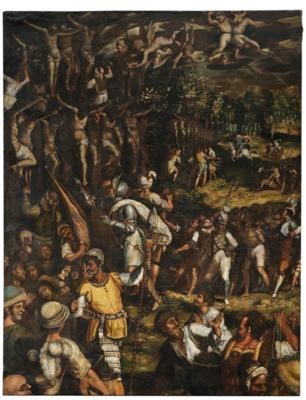Spanish School, 16th Century
Martyrdom of the Ten Thousand,
oil on canvas, 265 x 205 cm, unframed
Possible literature:
F. Abbate, Storia dell’arte nell’Italia meridionale. Il Cinquecento, Rome 2001, p. 40 (as Juan de Matta)
This canvas, which was originally part of a larger altarpiece, depicts the martyrdom of the Ten Thousand on Mount Ararat, a legend that spread throughout Europe from the 13th century onwards. According to medieval martyrologies, a certain Acacius, a Roman officer in the employ of Emperor Hadrian, led a military expedition to Armenia under the command of ten thousand soldiers. Initially beaten, they were all converted to Christianity by the sudden appearance of an angel, and then managed to defeat the enemy. After hearing the news of their conversion, the emperor ordered the soldiers to be crucified on Mount Ararat. Their numerous relics were later sent throughout the West, particularly to Spain.
This is a fairly frequent iconography in the area of Switzerland and southern Germany, and its best-known representation is certainly the large painting by Albrecht Dürer executed for Frederick of Saxony in 1508, now in the Kunsthistorisches Museum in Vienna. In the present painting, the figure visible in the foreground with a thin halo is to be identified as Saint Acacius, characterised by the crown of thorns and the recognisable acacia branch above his head. The figures intent on crucifying the Christian soldiers are dressed in oriental costumes, with turbans, sashes and exotic knee-length trousers, because according to the story, the main enemies of Rome, such as the Parthians and other Caucasian peoples, were involved in the martyrdom.
In his volume on 16th-century painting in Southern Italy Francesco Abbate mentions a painting with the same subject, attributing it to the Spanish painter Juan de Matta, documented in Palermo in 1536–1537. After a sojourn in Naples at the beginning of the 16th century, the artist moved to Sicily, establishing his workshop in Polizzi Generosa, a town of political and artistic importance at the time, sending his works to numerous other centres, such as Cefalù and Caltagirone. Some of his works – a Last Supper and a fragmentary Last Judgement – can be seen today in the Mandralisca Museum in Palermo.
Specialist: Mark MacDonnell
 Mark MacDonnell
Mark MacDonnell
+43 1 515 60 403
mark.macdonnell@dorotheum.at
25.10.2023 - 18:00
- Realized price: **
-
EUR 26,000.-
- Estimate:
-
EUR 25,000.- to EUR 30,000.-
Spanish School, 16th Century
Martyrdom of the Ten Thousand,
oil on canvas, 265 x 205 cm, unframed
Possible literature:
F. Abbate, Storia dell’arte nell’Italia meridionale. Il Cinquecento, Rome 2001, p. 40 (as Juan de Matta)
This canvas, which was originally part of a larger altarpiece, depicts the martyrdom of the Ten Thousand on Mount Ararat, a legend that spread throughout Europe from the 13th century onwards. According to medieval martyrologies, a certain Acacius, a Roman officer in the employ of Emperor Hadrian, led a military expedition to Armenia under the command of ten thousand soldiers. Initially beaten, they were all converted to Christianity by the sudden appearance of an angel, and then managed to defeat the enemy. After hearing the news of their conversion, the emperor ordered the soldiers to be crucified on Mount Ararat. Their numerous relics were later sent throughout the West, particularly to Spain.
This is a fairly frequent iconography in the area of Switzerland and southern Germany, and its best-known representation is certainly the large painting by Albrecht Dürer executed for Frederick of Saxony in 1508, now in the Kunsthistorisches Museum in Vienna. In the present painting, the figure visible in the foreground with a thin halo is to be identified as Saint Acacius, characterised by the crown of thorns and the recognisable acacia branch above his head. The figures intent on crucifying the Christian soldiers are dressed in oriental costumes, with turbans, sashes and exotic knee-length trousers, because according to the story, the main enemies of Rome, such as the Parthians and other Caucasian peoples, were involved in the martyrdom.
In his volume on 16th-century painting in Southern Italy Francesco Abbate mentions a painting with the same subject, attributing it to the Spanish painter Juan de Matta, documented in Palermo in 1536–1537. After a sojourn in Naples at the beginning of the 16th century, the artist moved to Sicily, establishing his workshop in Polizzi Generosa, a town of political and artistic importance at the time, sending his works to numerous other centres, such as Cefalù and Caltagirone. Some of his works – a Last Supper and a fragmentary Last Judgement – can be seen today in the Mandralisca Museum in Palermo.
Specialist: Mark MacDonnell
 Mark MacDonnell
Mark MacDonnell
+43 1 515 60 403
mark.macdonnell@dorotheum.at
|
Buyers hotline
Mon.-Fri.: 10.00am - 5.00pm
old.masters@dorotheum.at +43 1 515 60 403 |
| Auction: | Old Masters |
| Auction type: | Saleroom auction with Live Bidding |
| Date: | 25.10.2023 - 18:00 |
| Location: | Vienna | Palais Dorotheum |
| Exhibition: | 14.10. - 25.10.2023 |
** Purchase price incl. charges and taxes
It is not possible to turn in online buying orders anymore. The auction is in preparation or has been executed already.

